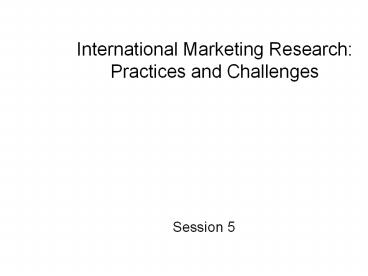International Marketing Research: Practices and Challenges - PowerPoint PPT Presentation
1 / 24
Title:
International Marketing Research: Practices and Challenges
Description:
International Marketing Research: Practices and Challenges Session 5 Learning Objectives Define international marketing research and provide a description of its ... – PowerPoint PPT presentation
Number of Views:367
Avg rating:3.0/5.0
Title: International Marketing Research: Practices and Challenges
1
International Marketing ResearchPractices and
Challenges
- Session 5
2
Learning Objectives
- Define international marketing research and
provide a description of its immense scope offer
examples of each type of research conducted in
international marketing - Describe the steps involved in the international
marketing research process while addressing, for
each step, the international constraints involved - Introduce the concept of decision support systems
for international marketing and describe the
sales forecasting process
3
International Marketing Research
- International marketing managers need to
constantly monitor the different forces affecting
their international operations - International marketing research is especially
complex
4
International Marketing Research
International marketing research is the
systematic design, collection, recording,
analysis, interpretation, and reporting of
information pertinent to a particular marketing
decision facing a company operating
internationally.
5
Research of Industry, Market Characteristics, and
Trends
- Acquisition analyses
- Diversification analyses
- Market-share analyses
- Export research
6
International Buyer Behavior Research
- Brand preferences
- Brand attitudes
- Brands awareness studies
- Purchase behavior studies
- Consumer segmentation studies
7
International Product Research
- Concept development and testing studies
- Brand name generation and testing
- Product testing
- Competitive product studies
- Packaging design studies
- Test marketing
1
8
International Distribution Research
- Import/export analyses
- Channel performance and coverage
- Plant/warehouse location studies
9
International Promotion Research
- Studies of premiums, coupons, and deals
- Advertising effectiveness research
- Local media research
- Studies pertaining to personal selling activities
- Sales Force Compensation
- Quota
- Territory
10
International Pricing Research
- Studies projecting demand
- Currency and counter trade studies
- Studies of inflation rates and pricing
- Studies of negotiation tactics
11
The International Marketing Research Process
- STEP 1 Define the international research problem
and agree on the research objectives - Exploratory Research
- Descriptive Research
- Causal Research
- STEP 2 Set specific objectives
12
The International Marketing Research Process,
continued
- STEP 3 Develop the International Research Plan
- STEP 4 Define Information Sources
- Secondary Data
- Researchers must determine if the information is
available, and, if so, how reliable it is - Internal data is useful only if company has
collected similar info from relevant respondents
in a country with similar environment
13
Secondary Data Constraints
- Conceptual Equivalence
- Concepts have different meanings in different
cultural environments - Functional Equivalence
- Products themselves may be used for different
purposes in different country environments
14
Secondary Data Constraints, continued
- Availability, Reliability, and Validity
- Accuracy of secondary data can be questionable
Published statistics may be unreliable - Sources of reliable data
- World Bank
- United Nations Development Program
- Organization of Economic Cooperation and
Development (OECD) - Euromonitor
15
Primary Data
- Information collected for a specific purpose, to
address the problem at hand. - The costs of collecting primary data in foreign
markets are likely to be much higher given the
lack of an appropriate marketing research
infrastructure
16
Primary Data Research Approaches
- Qualitative research has been particularly useful
as a first step in studying international
marketing phenomena. - Focus Groups
- Observation
- Constraints Responses can be affected by
culture, individuals may act differently if they
know they are being observed.
17
Primary Data Research Approaches, continued
- Quantitative research are more structured,
involving either descriptive research approaches,
such as survey research, or causal research
approaches, such as experiments. - Content Analysis
- Survey Research
- Experimental Research
- Constraints Respondent factors, infrastructure
factors
18
Data Collection
- STEP 5 Design Data Collection Instrument
- Emic instruments measure phenomena specific to
each culture. - Etic instruments measure the same phenomenon in
different cultures. - Constraints Translation Instrument Reliability
Reluctance to answer certain questions
19
Data Collection, continued
- STEP 6 Decide on the Sampling Plan
- Sample Unit
- Sample Size
- Sampling Procedure
- STEP 7 Collect, Analyze, and Interpret Data
20
Decision Support Systems for Global Marketing
- A coordinated collection of data, systems, tools,
and techniques, complemented by supporting
software and hardware designed for the gathering
and interpretation of business and environmental
data
21
Sales Forecasting
- Sales Force Composite Estimates
- Personal observations and expectations of the
local sales force - Jury of Expert Opinion
- Opinions of different experts about future demand
- The Delphi Method
- Experts to estimate market performance findings
are aggregated, and experts are queried again, in
light of aggregate responses
22
Sales Forecasting, continued
- Time Series and Econometric Models
- Use data of past performance to predict future
market demand - Analogy Methods
- Estimation method that relies on developments and
findings in markets - With similar levels of economic development, or
- Where the product is in the same market
development stage, or - In markets which share similar cultural
characteristics
23
Sales Forecasting, continued
- Point of Sale Research
- Made with the help of store scanners, in markets
where they are available - Involve comprehensive store audits
24
Summary
- Defined international marketing research
- Described steps involved in the international
marketing research process and related
international constraints - Discussed marketing decision support systems
and international sales forecasting































